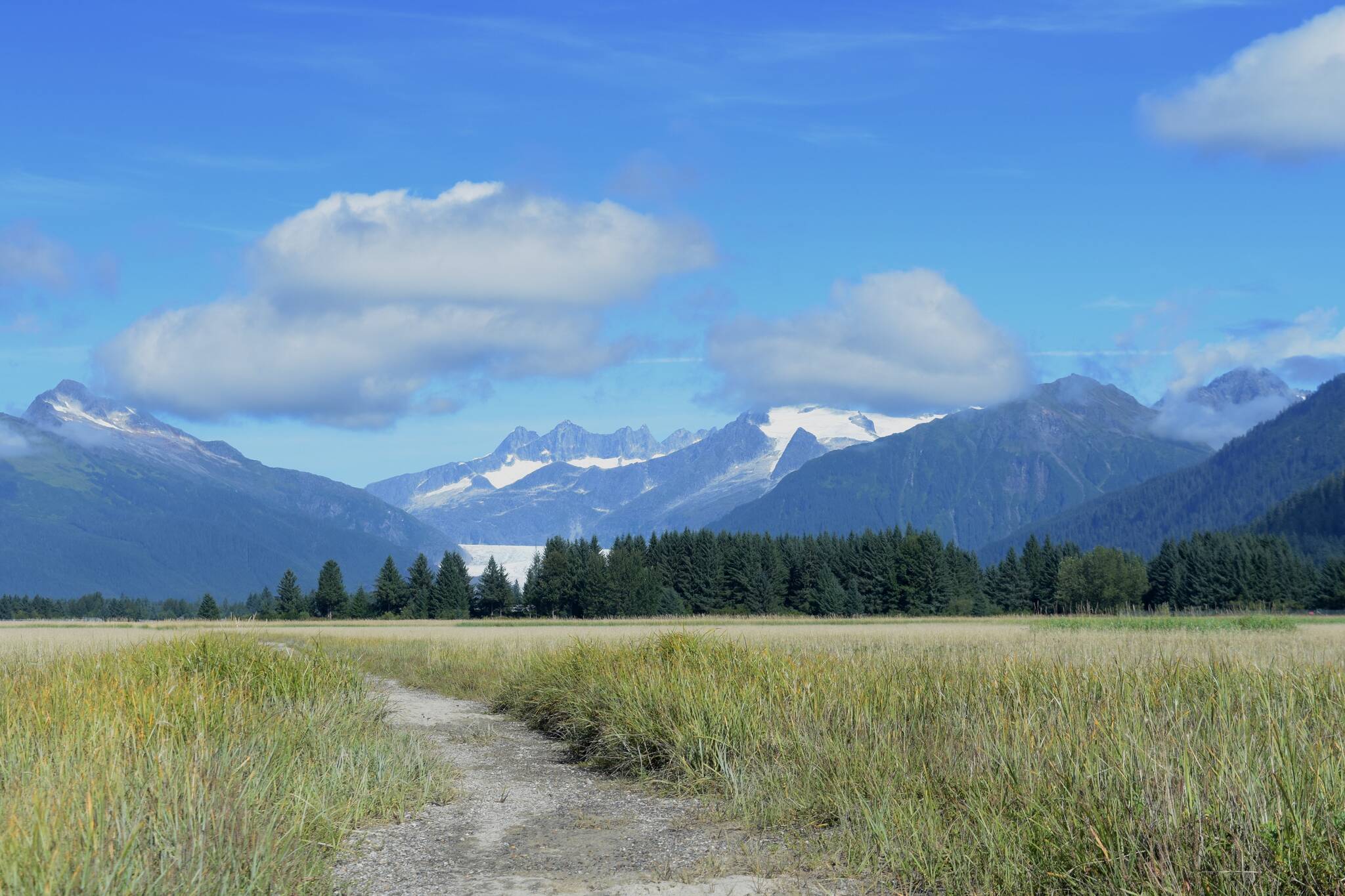The Mendenhall Wetlands span Gastineau Channel roughly from Salmon Creek estuary north (and west) to the end of the Mendenhall Peninsula. This expansive area encompasses a great variety of habitats, including the saltwater channel, glacial rivers, clear-water streams, tidal sloughs, uplift meadows, vegetated salt marsh (high marsh with grasses, low marsh with sedges), sand and mud flats (some of them with low vegetation), patches of conifer trees, and “edge” (where salt marsh abuts forest).
The area is notable for the many species of birds that can be seen there. At last report, some 230 species have been recorded out there, and it’s been designated as an Important Bird Area by the National Audubon Society. Important Bird Areas are places essential for the maintenance of viable bird populations because they support large concentrations of birds, provide habitat for threatened or rare species, or support species that have a very restricted geographic distribution. The goal is to identify, monitor and protect critical habitats. The area has been identified as a stop along the Southeast Alaska Birding Trail, a web-based guide for ecotourism.
The wetlands draw everyone who is interested in nature. This is a destination for local educational field trips, such as those by Discovery Southeast, which typically focus on the wetland birds and their adaptations, as well as art classes. The wetlands receive a variety of recreational uses, which include hiking, photography, dog-walking, hunting, birding, fishing, fund-raiser runs, and so on.
The grassy meadows are used by nesting savannah sparrows. Other small songbirds (such as Wilson’s warbler) nest and forage in the shrubs at the forest edges. But the heaviest avian use of the area is in the ‘off’-season, when nesting is over. Overwintering and migrating birds sometimes congregate in large numbers, feeding and resting. Waterfowl are diverse and numerous. Diving ducks forage in the deeper waters, while mallards and other dabblers focus on shallow waters. Geese of several species (commonly Vancouver Canada goose, a subspecies that is specific to Southeast Alaska) graze on the sedges and other low vegetation. Small songbirds such as mountain bluebirds, snow buntings, and Lapland longspurs appear on migration. Migrating raptors, including short-eared owls and harriers, hunt voles and small birds there. Resident and visiting eagles perch in the trees on the forest edge, resting and scanning the area for prey such as salmon and birds. Populations of some of these species have declined greatly (e.g., savannah sparrow, short-eared owl, to mention just two).
One of the most important uses of the wetlands is by migrating shorebirds. Over forty species of shorebird have been recorded there. Shorebirds probe the rich mud for polychaete worms, small clams, and other invertebrates; they depend on this limited habitat to refuel on their long migrations. The wetlands can be considered a ‘rest stop’ without which the birds would not be able to complete their long journeys. Most shorebirds have small global populations, and decades of monitoring show that many of them have already experienced significant population declines. For example, pectoral sandpiper, lesser yellowlegs, and short-billed dowitcher are three such species that have suffered losses; all use the Mendenhall Wetlands regularly. This wetland is one of only three large tidewater wetlands in Southeast Alaska (the others are at Yakutat and the Stikine River delta) that provide critical habitat for shorebirds on both spring and fall migrations.
Many mammals use the wetland too, from grazing bears and browsing deer and wandering porcupines to voles nesting in the high marsh. River otters, mink, and weasels sometimes hunt for food in the area. Salmon migrate up several streams to spawn and their juveniles move back out to sea. Seals sometimes come upriver, hunting fish. Boreal toads, local amphibians of a seriously declining species, have spawned in certain places in the wetland complex, their tadpoles rearing in small ponds near the forest edge. Furthermore, invertebrates must be quite abundant, providing critical food for the shorebirds and ducks, although good data are needed.
Juneau is very fortunate to have this rich biological resource at its doorstep, proving useful habitat for wildlife and a scenic place for everyone to enjoy. In addition to being important habitat for birds (and other animals), the area is used for a variety of recreational activities. Unfortunately, the well-being of the area is at risk from several sources, including pollution (e.g., if the sewage disposal system fails), potential airport and other urban development, runoff from roadways that drain into the wetlands, accumulating expended shotgun shells and cigarette butts and other litter, and dogs that are allowed to chase birds. Potential bridge construction would bring serious disturbances during construction and a likely source of littering and perhaps pollution. We hope the future will include steps to maintain the well-being and integrity of this rich, irreplaceable resource.
• Mary Gwen S. Baluss studies birds in Southeast Alaska and is an at-large board member for the Juneau Audubon Society. Marsha S. Squires is president of the Juneau Audubon Society. Mary F. Willson is a retired professor of ecology. Columns, My Turns and Letters to the Editor represent the view of the author, not the view of the Juneau Empire. Have something to say? Here’s how to submit a My Turn or letter.

